Stop Sudah English-revised-March2012 - International Center for ...
Stop Sudah English-revised-March2012 - International Center for ...
Stop Sudah English-revised-March2012 - International Center for ...
You also want an ePaper? Increase the reach of your titles
YUMPU automatically turns print PDFs into web optimized ePapers that Google loves.
up paying prostitutes and buying liquor. 92<br />
It is estimated that HIV/AIDS was first seen in Papua in 1992. Various factors influence the rapid<br />
progression of HIV/AIDS in Papua, including the movement of the population, little in<strong>for</strong>mation about<br />
reproductive health and access to contraception, women’s powerlessness to protect themselves, and also<br />
the emergence of houses of prostitution in various areas in Papua. HIV/AIDS cases have been found in all<br />
districts of Papua and the number increases every year. 93<br />
The increase in the number of HIV/AIDS cases in Papua is alarming. Results of Integrated Surveillance of<br />
HIV and Behaviour (STHP) conducted in 2006 state that Papua has the highest proportion of AIDS cases<br />
compared with other provinces in Indonesia.<br />
[AIDS cases in Papua] . . . are . . . the second highest after Jakarta. However, when compared with the<br />
population, then the case rate (total cases/total population x 100,000) in Papua there are 60.93 per 100,000<br />
peope . . . 15.39 times higher than the national rate (3.96). While in West Irian Jaya [West Papua] it is as high<br />
as 10.24 per 100,000 people, or 2.59 times higher than the national rate. 94<br />
Papuan women are vulnerable to HIV/AIDS infection from their partners. Papua Provincial Health Bureau<br />
data as of March 2009 indicate that as many as 4,545 people in Papua Province are known to be infected<br />
with HIV/AIDS. Data of people with HIV/AIDS per district are: Biak District: 453 cases; Jayapura<br />
District: 298 cases; Jayapura City: 231 cases; Keerom District: 2 cases; Puncak Jaya District: 19 cases; Nabire<br />
District: 607 cases; Jayawijaya District: 118 cases; Merauke District: 1028 cases; Mimika District: 1879 cases.<br />
If a person with a positive HIV/AIDS status has sex with more than one person, it is difficult to trace who<br />
spread HIV/AIDS to whom. Transmission of HIV/AIDS does not only occur through unprotected sexual<br />
intercourse, but can be transmitted through other means, such as the use of unsterile needles or through<br />
blood transfusions that are not examined. Nevertheless, the Documentation Team found several cases<br />
where the wife was powerless to protect herself from HIV/AIDS. The wife obviously could not control the<br />
sexual behavior of her husband to ensure he always had safe sex, so it is appropriate that these cases are<br />
included as an impact of domestic violence.<br />
I married at 14; I was still in elementary school, grade V. At that time I was <strong>for</strong>ced by my family to get married<br />
according to custom to a tribal chief who already had three wives. I tried to refuse because I was still small and<br />
wanted to attend school like other friends, but because the tribal chief constantly pressured my family I had no choice<br />
but to marry him through a traditional ceremony to become his fourth wife. The three other wives accepted me well<br />
and taught me how to behave as the wife of a chieftain, including how to garden, raise pigs, serve the community, and<br />
serve my husband. After one year of marriage, the chieftain brought a woman from the town of Wamena and told us<br />
that she was the fifth wife. Since the presence of the fifth wife, our family began to get sick one by one, starting with<br />
my husband who got ill, then died, and was followed by the fifth wife, then the third wife, then the . . . [second]<br />
wife, and the first wife. They all died the same year. Because I was also sick, my parents and siblings decided to take<br />
me to the hospital in Wamena. After being examined, I [learned that I] was infected with HIV/AIDS. The<br />
92 Interview with Rev. Dora Balubun, STh, Abepura, September 2008.<br />
93 R. M. Pratiwi, “Gema Suara Perempuan Papua,” [“The Tremor of Papuan Women’s Voices,”] Jurnal Perempuan<br />
(December 2008), http://www.arsip.jurnalperempuan.com/index.php/jpo/comments/gema_suara_ perempuan_papua/. This<br />
article covers a national seminar conducted by the National Women’s Commisson and the Women’s Working Group of the<br />
Papua People’s Council to commemorate the 10 th anniversary of the National Women’s Commission. In<strong>for</strong>mation about the<br />
onset of HIV/AIDS in Papua comes from a speaker at this event.<br />
94 The Situation of Risky Behavior and the Prevalence of HIV in the Land of Papua 2006: STHP Results 2006 in the Land of<br />
Papua (Central Statistics Bureau and Department of Health, 2007), p. i. The Department of Health and the Health Bureau <strong>for</strong><br />
the Land of Papua conducted this survey in cooperation with the central and provincial divisions of the AIDS Reduction<br />
Commission, and the Central Bureau of Statistics in September-October 2006.<br />
ENOUGH IS ENOUGH! 48



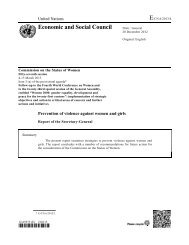
![IANSA [PDF, 2MB] - PeaceWomen](https://img.yumpu.com/25206379/1/190x123/iansa-pdf-2mb-peacewomen.jpg?quality=85)
![Commitments Sample [PDF, 93KB] - PeaceWomen](https://img.yumpu.com/25206331/1/190x245/commitments-sample-pdf-93kb-peacewomen.jpg?quality=85)


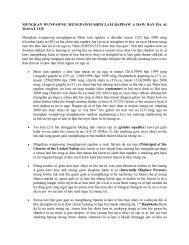
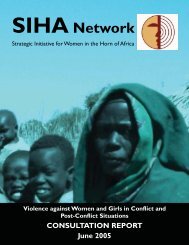



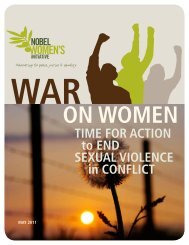
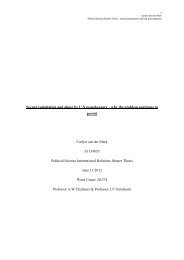

![A Toolkit for Advocacy and Action [PDF, 260KB] - Peace Women](https://img.yumpu.com/25205989/1/190x245/a-toolkit-for-advocacy-and-action-pdf-260kb-peace-women.jpg?quality=85)